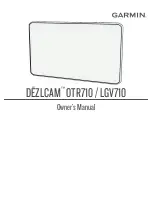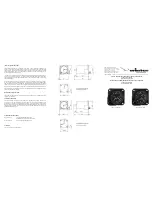
).
QUICK EDIT
: Allows you to quickly edit the range, direction of
fire, and wind information (
).
NOTE:
When you change the direction of fire, the wind
direction updates automatically. The wind direction can be
edited independently of the direction of fire.
ENVIRONMENT
: Allows you to customize atmospheric
conditions for your current environment. You can enter
custom values, use the pressure value from the internal
sensor in the device, or use the temperature value from a
connected tempe sensor.
TARGET
: Allows you to customize long-range shooting
conditions for your current target. You can change the
selected target, and customize conditions for up to ten
targets (
).
PROFILE
: Allows you to customize gun (
) and bullet properties (
) for your current profile. You can change the
selected profile (
) and add
additional profiles (
).
CHANGE FIELDS
: Allows you to customize the data fields on
the Applied Ballistics page (
).
SETUP
: Allows you to select the output and input units of
measure for the Applied Ballistics page.
Customizing the Range Card Fields
1
From the Applied Ballistics page, select
ENTER
>
RANGE
CARD
>
ENTER
>
CHANGE FIELDS
.
2
Select or to scroll through the available fields.
3
Select
ENTER
to save your selection and move to the next
field.
4
Select
PAGE
to save your changes.
Editing the Range Increment
1
From the Applied Ballistics page, select
ENTER
>
RANGE
CARD
>
ENTER
>
RANGE INCREMENT
.
2
Follow the on-screen instructions.
Setting the Base Range
1
From the Applied Ballistics page, select
ENTER
>
RANGE
CARD
>
ENTER
>
BASE RANGE
.
2
Follow the on-screen instructions.
Changing the Target
1
From the Applied Ballistics page, select
ENTER
>
TARGET
>
TARGET
>
CHANGE TARGET
.
2
Select a target.
The long-range shooting conditions for the selected target
appear.
Editing the Name of a Target
From the Applied Ballistics page, select
ENTER
>
TARGET
>
TARGET
>
EDIT NAME
.
Changing the Profile
1
From the Applied Ballistics page, select
ENTER
>
PROFILE
>
PROFILE
.
2
Select a profile.
3
Select
CHANGE PROFILE
.
The gun and bullet properties for the selected profile appear.
Adding a Profile
You can add a .pro file that contains profile information by
transferring the file to the AB folder on the device (
).
1
From the Applied Ballistics page, select
ENTER
>
PROFILE
>
PROFILE
>
+ PROFILE
.
2
Select an option:
• To customize the bullet properties, select
BULLET
PROPERTIES
(
).
• To customize the gun properties, select
GUN
PROPERTIES
(
).
Editing the Name of a Profile
1
From the Applied Ballistics page, select
ENTER
>
PROFILE
>
PROFILE
.
2
Select a profile.
3
Select
EDIT NAME
.
Editing Bullet Properties
1
From the Applied Ballistics page, select
ENTER
>
PROFILE
>
BULLET PROPERTIES
.
2
Select an option:
• To automatically enter bullet properties from the Applied
Ballistics bullet database, select
BULLET DATABASE
,
and select the bullet caliber, manufacturer, bullet, and
drag curve from the available options.
NOTE:
You can select the caliber of your bullet to search
a list of bullets within that caliber. Not all bullet names
match the actual bullet caliber. For example, a 300 Win
Mag is a .308 caliber bullet.
• To manually enter bullet properties if your bullet is not in
the bullet database, select or to scroll through each
field, and select
ENTER
to edit the values.
NOTE:
You can find this information on your bullet
manufacturer's website.
Editing Gun Properties
1
From the Applied Ballistics page, select
ENTER
>
PROFILE
>
GUN PROPERTIES
.
2
Select or to scroll through each field, and select
ENTER
to edit the values.
3
Select an option:
• To calibrate the muzzle velocity, select
CALIBRATE
MUZZLE VELOCITY
, enter the range and true drop, and
select
USE
.
NOTE:
Garmin
®
recommends you calibrate the muzzle
velocity prior to the drop scale factor. Calibrating the
muzzle velocity provides a more accurate solution in the
supersonic range for your specific firearm.
• To calibrate the drop scale factor, select
CALIBRATE
DSF
, enter the range and true drop, and select
USE
.
NOTE:
Calibrating the drop scale factor provides a more
accurate solution in the transonic range for your specific
firearm.
The drop scale factor table is populated after calibrating the
muzzle velocity and drop scale factor.
4
Select
VIEW DSF TABLE
to review the drop scale factor
table based on Mach speeds and calibrated drop scale factor
values.
5
Select
MV-TEMP TABLE
to review muzzle velocity
adjustments based on the ambient temperature.
Clearing the Drop Scale Factor Table
The drop scale factor table is populated after you calibrate the
muzzle velocity and drop scale factor. If necessary, you can
reset the table values to zero.
From the Applied Ballistics page, select
ENTER
>
PROFILE
>
GUN PROPERTIES
>
VIEW DSF TABLE
>
ENTER
>
CLEAR DSF TABLE
.
Customizing Your Device
5




































